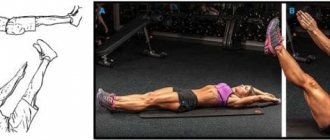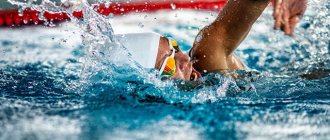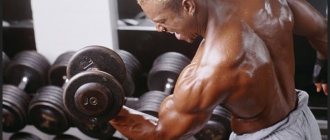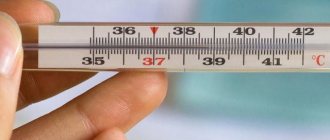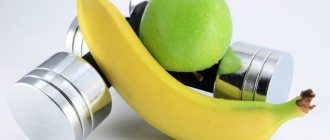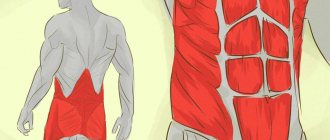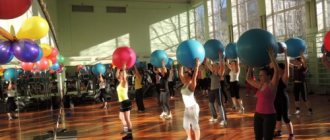Any physical exercise is performed with the help of muscles. In order for a muscle to do work (for it to contract), energy is needed.
The human body can store energy in different forms. The main source of energy is glycogen (produced from carbohydrates), the second most important, reserve source is lipids (produced from fats).
The body stores this energy in different organs and tissues. But its main storage areas are muscles and liver.
Anaerobic load is the load that a muscle performs using its internal energy resources without access to oxygen.
Sounds a little abstruse. But, believe me, this is the simplest and most concise definition. Without introducing you to the bizarre world of glycolysis, anaerobic threshold and the like.
To simplify even more (people wince at science), then anaerobic exercise is a type of exercise without access of oxygen to the muscle.
With an anaerobic energy supply mechanism, muscle cells work only from internal energy resources. And since the energy reserves in the muscle are small, its work lasts a short period of time. Depending on the intensity of the load, this ranges from 2-3 seconds to 2-3 minutes of muscle activity.
SUMMARY
In anaerobic exercise, the key factor is the lack of oxygen access to the working muscle.
Aerobic and anaerobic training, differences
All physical exercises are divided into two large groups: aerobic and anaerobic (strength). The training process and muscle load have a number of distinctive features.
Aerobic training - load features
Aerobic training is one or a set of exercises performed at a calm pace for at least 30 minutes.
Examples of aerobic training.
- Nordic walking, easy running;
- skiing, skating, cycling;
- swimming, rowing, volleyball, basketball, tennis.
Features of aerobic exercises.
1. Pulse rate within 50-80% of the maximum heart rate (MHR).
2. Almost all muscle groups work.
3. The main work is performed by “slow” muscle fibers.
4. Aerobic exercise “burns” carbohydrates and fats.
Anaerobic training - load features
Anaerobic training is strength training. The goal is to increase muscle size and increase physical strength.
Exercises are performed in short approaches from a few seconds to 2 minutes. The muscles work “explosively”, to the limit of their capabilities. Then comes the rest stage, and the exercise is repeated.
Examples of anaerobic exercises.
- lifting the bar;
- sprint running;
- pull-ups, push-ups;
- working on strength training equipment.
Features of anaerobic exercises.
1. Pulse rate within 90% of MHR .
2. Exercises are performed in isolation, on a small muscle group.
3. “Fast” muscle fibers work .
4. Anaerobic exercise “burns” only carbohydrates.
Aerobic sports
- Swimming
- here, during training and performances, the muscles of both the upper and lower parts of the body are involved. During swimming, the joints are not overloaded, there is no need to support your own weight. Therefore, the likelihood of injury to the skeleton and muscles is reduced to zero. - Skiing
is the most advanced type of aerobic physical activity. Many muscles are involved here. As a result, the degree of aerobic fitness increases. The effect of such activities is further enhanced by the additional mass - equipment and clothing. Special exercise machines that simulate skiing help you actively burn extra calories, which means you can quickly lose those hated kilograms of weight. - A simulator
that simulates climbing stairs - almost every modern gym has such an active assistant in the fight against excess weight. During training on assistant simulators, the muscles of important parts of the body are involved - we are talking about the back, buttocks and legs. As a result, it becomes possible to provide an impressive level of energy consumption in a short period of time. - Aerobic dancing
- in such trainings you perform rhythmic movements to a fairly fast melody. To increase the intensity of the load, benches are used. Their height ranges from fifteen to thirty centimeters. Combined with other workouts, these aerobic exercises will help get rid of fat accumulation. -
strength training Here you alternately train on various training assistants for 15–20 seconds. If the classes are structured correctly, you can quickly notice positive results in the functioning of the heart and blood vessels. Muscle tone is strengthened and increased, and a sufficient number of calories are burned. - Jumping rope
is an intense type of physical activity that can be a real assistant in losing weight. - Jogging in place
, on a mini-trampoline - this type of aerobic activity should be used in the initial phase of training. Later, intense activities are more appropriate. - Aqua aerobics
- exercises performed in water. Exercises help you lose weight if you take an integrated approach to this goal.
What is the main and most vital effect of this type of activity? The answer is quite simple - increasing muscle strength.
Where do muscles get energy from?
Let's not dive into chemical and biological terms. Let's compare a person with a machine and understand where the muscles get their energy.
To keep the wheels spinning, you need gasoline. It burns out in the engine. For arms and legs to work, you need an ATP molecule. It “burns” in the muscles.
Adenosine triphosphoric acid or adenosine triphosphate (abbreviated as ATP) is a universal source of energy for all biochemical processes, including muscle function.
When a muscle contracts, the adenosine triphosphate molecule breaks down into smaller components. The breakdown of ATP is accompanied by the release of heat and energy. It turns out that adenosine triphosphate “burns” and gives us strength.
Adenosine triphosphoric acid is a kind of fuel for the body.
To make the car go faster, we press the gas pedal. Thus, we increase the amount of gasoline flowing from the gas tank to the engine.
Muscles work the same way. To run a cross-country race or lift a weight, you need many, many ATP molecules. Where can I get them? That's right - press on the gas pedal, speed up your metabolism.
Aerobic and anaerobic exercise - principles of metabolism
Let's discard the abstruse formulations. Let's look at aerobic and anaerobic exercise through the eyes of an athlete.
It is an established fact that physical activity speeds up metabolism. Let's find out how this happens.
the story of how carbohydrates turn into simple sugars . Chemistry fans can follow the link.
Let's leave carbohydrates the right to be called carbohydrates and move on.
Metabolism of the body through the eyes of an athlete
Metabolism is the metabolism of substances in the body. Physical exercise stimulates metabolic processes. Muscles need “gasoline” and the body speeds up metabolism.
Food products are derivatives of the ATP molecule. Metabolism “breaks down” food into molecules and produces “fuel”.
Carbohydrates are burned first, then fats. Only in extreme cases is the ATP molecule produced from proteins.
To obtain energy, the body synthesizes and “burns” ATP molecules continuously. The higher the physical activity, the more fuel you need.
Our body has two gas tanks - glycogen and fat tissue.
In the topic “ Living and Dead Calories ” we already talked about how the body uses carbohydrates and fats. Let's develop the question and look at it with an example.
You ate three pieces of chocolate. Chocolate is carbohydrates. One piece of chocolate will “burn” immediately. While you are walking around the apartment, washing your face, getting dressed. This is minimal physical activity.
The body converts the rest of the chocolate to create energy reserves. Metabolism will “pack” the second lobe into glycogen. The third slice (and the entire chocolate bar) will be sent to adipose tissue for preservation.
glycogen in the muscles and liver. This is gas tank number 1 - a source of fast energy. When the muscles begin to work intensively, the body will refuel from this tank. Metabolism will “unpack” glycogen and create an ATP molecule.
Adipose tissue is gas tank No. 2. Fat is the main source of energy for any living creature. Homo sapiens is no exception.
The body constantly increases its reserves of adipose tissue. Sends unused fats and carbohydrates there. Creates reserves in case of hunger or prolonged stress. Let's run a cross-country race, the body will “refuel” from this tank.
Fine. We sorted out the gas station and filled the tanks. Now let's see where the "gasoline" goes. Let's find out how the body uses reserves.
Aerobic and anaerobic exercise are two systems for providing energy during exercise. They can proceed in parallel or independently of each other. The fundamental difference is as follows.
Aerobic exercise synthesizes ATP from carbohydrates and fats, anaerobic exercise only from carbohydrates.
How aerobic exercise speeds up metabolism
Aerobic exercise is the performance of low-intensity exercise, during which energy is synthesized under the influence of oxygen.
This load triggers a corresponding process in the body. The word “aerobic” comes from the Greek άήρ (aer) - air. The name speaks for itself.
Let's imagine. You are pedaling a bicycle or running a cross-country race. The body is under stress and needs “doping”. Where to get?
The closest source of energy is glycogen (“gas tank No. 1”). It is found in the muscles and liver.
Muscles work and require food. The lungs intensively draw in air. The heart pumps blood and supplies oxygen. Under the influence of excess oxygen, the synthesis of ATP from glycogen begins.
This reservoir has a limited resource. After 20–40 minutes, all carbohydrates will be “burnt.” And oxygen will reach the main energy reserves - fat cells (gas tank No. 2).
The body can use fat as an energy source for many hours. But there is one condition.
The load should be moderate. If the load level increases sharply, metabolism will take a different path.
Anaerobic load - oxygen-free metabolism
Anaerobic exercise is the performance of strength or “explosive” exercises, during which energy is synthesized without the participation of oxygen. “An” is a negative prefix (without-).
Anaerobic metabolism occurs in an oxygen-free manner. In this case, only carbohydrates are burned.
Converting adipose tissue into an ATP molecule is a long process. It takes a lot of time.
Muscles will not wait for oxygen to “unpreserve” the fat cell. If you need to lift a barbell, then you need strength here and now. Therefore, the body chooses the emergency route.
The body receives energy from molecules that are found in the muscles themselves.
To make it clear, we divide the anaerobic process into two stages. The stages can proceed in parallel or replace each other.
The first stage is ATP-CP. A small amount of ATP is always in the muscles. But ready-made supplies last only 1–2 seconds.
In order for muscles to work, the body urgently resynthesizes (restores) adenosine triphosphoric acid. To do this, creatine phosphate (CP) molecules are used. They are also stored in muscle tissue.
CF “burns” without the participation of oxygen. The decay energy goes into the production of ATP.
ATP and CP molecules “burn” in the thousands and give the muscles real power. This product lasts for 10–15 seconds.
There is enough time for a sprinter's snatch or a barbell press.
The second stage is glycolysis. When energy is needed urgently and a lot, metabolism synthesizes the ATP molecule from glycogen (“gas tank No. 1”) without the participation of oxygen. Silushka obtained in this way will last for 2 minutes.
Aerobic and anaerobic metabolism are parallel processes
Aerobic and anaerobic metabolism successively replace and complement each other.
The power load lasts from a few seconds to 2 minutes, maximum. Anaerobic processes lead to the release of lactic acid. Excess acid blocks muscle function.
After maximum tension, the muscle relaxes. During rest, the body utilizes lactic acid and restores ATP and CP molecules. Synthesis takes place with the participation of oxygen.
Thus: strength training is a combination of anaerobic and aerobic processes.
Effective complexes for weight loss
- Diet for weight loss.
If every day the rate of consumed kilocalories is reduced by about one hundred units, then in a year you can irreversibly lose 4.5 kg of body fat. But the body will most likely feel that there is less fat and will engage in metabolism - it will slow down. In addition, a slowdown in metabolism will be observed due to the fact that you will lose mostly muscle, and not the fat deposits themselves. As soon as you finish eating according to the rules of the diet, the weight will return again, and maybe even with excess. - And aerobic exercise.
It is important here to consume fewer calories than you burn, otherwise, even with impressive workouts, fat will gain rather than disappear. In half an hour of aerobics, you can actually burn 200 kilocalories more than if you had not started sports training. To reduce the caloric content of your diet as much as possible, you should reduce the figure of 100 kilocalories every day. - Aerobic strength exercises.
In fact, it is impossible to combine a whole week of aerobics and strength training. The thing is that aerobics is not very effective for burning extra calories. In addition, excessive aerobic training is a serious barrier to recovery from high-level strength training. If you still insist on aerobic training, then let it be training lasting no more than half an hour per week at 60–70% of your ideal heart rate. By exceeding these limits, you risk bringing your body to the breakdown of muscle tissue - it will be used to produce energy reserves. - Power training.
When there is a lack of strength training and there are not enough kilocalories in the body, weight begins to decrease due to the fact that fat deposits are burned. If you use a little muscle here, it will be just perfect - 1 kg of muscle can burn two hundred kilocalories per day. If you consume fewer calories than you burn, then in a year it becomes possible to burn twenty kilograms of fat for every kilogram of muscle gained. Half an hour of training a week is enough to achieve impressive results.
Strength training is a surefire way to success.
It's best to perform one high-intensity set of compound exercises - squats, deadlifts, bench and chest presses, push-ups and pull-ups. It is appropriate to reduce the number of calories by five hundred per day. As a result, fat will be burned at a rate of about half a kilo per week. In a year with such exercises, you will be able to lose 23 kilograms, while increasing your strength. You should add the number of repetitions of exercises, increasing this indicator with each session.
How many calories can you burn doing aerobic exercise?
The most effective way to burn fat is cycling. By pedaling, you can burn from 500 to 1000 kilocalories per hour. Step aerobics and swimming will “lighten” you by 800 kilocalories, and aerobic dancing - by 600–800.
Brisk walking is a great cardio workout that works intensely on your legs and stomach, as well as on those problem areas like your thighs. In an hour of walking you will get rid of about 360 kilocalories.
By controlling caloric intake, you can achieve an ideal figure at any age, not gain weight and always stay in shape. The main thing is to approach this issue correctly.
On the path to success, you should definitely consult with a specialist from the very beginning, and, of course, with your coach. Only a doctor can prepare the right program for losing excess weight, and only a trainer can prescribe the right set of classes to achieve what you want.
Video exercises for burning fat:
How aerobic and strength exercises help you lose weight
We figured out how the body burns calories under the influence of aerobic and anaerobic exercise. As a bonus, let’s say that fat will “go away” after training.
The body needs to restore energy balance. Therefore, it continues to break down fat cells. The weight loss process can be extended for another 2 hours. After aerobic exercise, do not eat fatty and carbohydrate foods.
Strength training gives you even more options for losing weight. Recall that the goal of anaerobic exercise is to load the muscles.
After training, the body intensively “feeds” the overworked muscles. Muscles are growing. The growth of muscle tissue entails additional energy consumption.
Therefore, bodybuilders lean on protein foods. Protein, as you know, is not an energy drink. And the body has to “burn” fat tissue. This process lasts more than 12 hours.

